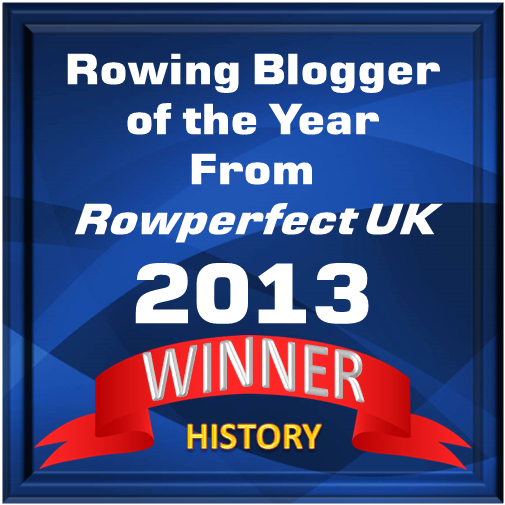Friday, July 19, 2013
The Story of the Martini Achter
Last Sunday, World Cup III ended in Lucerne, Switzerland. Following is the story of a special boat that was used by a U.S. crew to take the 1974 World Championships at Rotsee in Lucerne.
When visitors to Mystic Seaport – the Museum of America and the Sea, located in the village of Mystic, Connecticut, walk through the doors of the Visitors Reception Center at the Main Gate, the first thing they see, if they look up, is a magnificent racing shell hanging from the ceiling. This eight, the Martini Achter, is not only an indicator that the NRF’s National Rowing Hall of Fame is housed at Mystic Seaport, it is also on display because it has a remarkable place in the history of American rowing.
In 1973, after having raced at the European Championships in Moscow, a U.S. crew went to compete at the Heidelberg International Regatta in what was then West Germany. At Heidelberg, the Americans were short of one man in the eight race, the “Martini Achter Race”, where first prize was a brand new wooden eight which was built by the famous German boat builder Empacher in Eberbach. Joining the American oarsmen, Larry Gluckman, Calvin Coffey, Mike Vespoli, Hugh Stevenson, Terry Adams, Tim Mickelson, Ken Brown and Paul Hoffman, was the British rower Hugh Matheson (known to HTBS readers from entries about Chris Dodd’s brilliant book Pieces of Eight, published in 2012).
At the 1973 Heidelberg International Regatta, United States was the winner of the Martini Achter: Bow Larry Gluckman, 2 Calvin Coffey, 3 Hugh Matheson(GBR), 4 Mike Vespoli, 5 Hugh Stevenson, 6 Terry Adams, 7 Tim Mickelson, Stroke Ken Brown and Cox Paul Hoffman. Coach Steve Gladstone. From Peter Mallory's The Sport of Rowing.
In Peter Mallory’s splendid book The Sport of Rowing (2011), Gluckman is quoted saying that ‘Everybody wanted to win this beautiful Empacher wooden boat. It was like a piece of furniture.’ Norway entered a boat, too, and after the Americans had won the race, and the boat, Gluckman continued, ‘the Norwegians said, “Good row, America... and God Bless the Queen” because they knew one of our borrowed rowers, Hugh Matheson, was a Brit.’The Martini Achter stayed in Europe and came to belong to the NRF's fleet.
The following year, 1974, a slightly different U.S. crew went to compete at the World Championships in Lucerne, Switzerland, using the Martini Achter. The crew were: Bow Timothy Mickelson, 2 Kenneth Brown, 3 John Everett, 4 Mike Vespoli, 5 Mark Norelius, 6 Richard Cashin, 7 Hugh Stevenson, Stroke Alan Shealy and Cox David Weinberg, and Coach was Allen Rosenberg.
Here is a 3-minute film showing the eight practicing in the early summer of 1974 on Candlewood Lake in Connecticut before moving on to another training camp at Princeton, and then to Lucerne.
On the Rotsee, in an extremely tough race, which came to be known as “The Race of the Century,” the U.S. eight competed in the final against the world’s best rowing nations at that time, East Germany, Soviet Union, New Zealand, Great Britain and West Germany. New Zealand was in the lead for the first 1,800 metres, but then the crew in the Martini Achter put on a spurt which gave the Americans a slight lead. They managed to hold on to it and crossed the finish line as the World Champions. Another remarkable crew were the British who took a silver medal, despite having been dead last for most of the race. New Zealand came in third, East Germany forth, the Soviets fifth and West Germany sixth.
The Martini Achter was afterward used by the men’s varsity eight from Trinity College, Hartford, Connecticut, to win the 1976 Ladies’ Challenge Plate at the Henley Royal Regatta, and by the University of Washington men’s varsity eight to take the 1977 Grand Challenge Cup, also at Henley. Later the boat was sold to a club in England.
In an e-mail to HTBS, Mike Vespoli writes, that some English oarsmen
...rowed it over a submerged shopping cart and tore a big hole in it. It sat in rack at the Thames Tradesmen Rowing Club where I found it and bought it for 500 British pounds and brought it back to the U.S. I contacted my boat mates from the ‘74 crew and we all chipped in to get the boat restored so that we could take a row in 1999 at the world champs in St. Catherines, Ontario, Canada to celebrate our 25th anniversary. The restoration cost four times the original sale price!
The Martini Achter was restored by boat builder Graeme King in Putney, Vermont. He spent around 200 hours restoring the shell to its former beauty, he has told HTBS. It took 420 hours to build it originally and then the hull was formed by vacuum with three layers of Spanish cedar veneer over a mold. After that, the framework was fitted in. When restoring the shell, King used 3/32” plywood, then laminated on a sheet of 1/32” African mahogany veneer.
Here is some data of the Martini Achter:
Builder: Empacher boat builder, Eberbach, Germany.
Length: 57 feet
Weight: 250 lbs (boat), 8 oars, total 60 lb.
Top Speed: Over 3 miles, 18 feet/second; in a sprint, 22 feet/second
The last words go to Mike Vespoli:
If Mystic Seaport ever decides to remove the shell from public display then we [the ’74 crew] would take possession of it. It was also agreed that we could use this shell in 2024 to celebrate our 50th!
If this ever happens, HTBS promises to be there taking a picture.
Subscribe to:
Post Comments (Atom)












.jpg)
+Cambridge+Boat+of+2013..JPG)





No comments:
Post a Comment